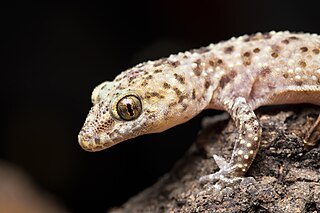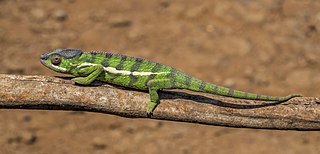
Gekkonidae is the largest family of geckos, containing over 950 described species in 62 genera. The Gekkonidae contain many of the most widespread gecko species, including house geckos (Hemidactylus), the tokay gecko (Gekko), day geckos (Phelsuma), the mourning gecko (Lepidodactylus), and dtellas (Gehyra). Gekkonid geckos occur globally and are particularly diverse in tropical areas. Many species of these geckos exhibit an adhering ability to surfaces through Van der Waals forces utilizing intermolecular forces between molecules of their setae and molecules of the surface they are on.

Hemidactylus is a genus of the common gecko family, Gekkonidae. It has 195 described species, newfound ones being described every few years. These geckos are found in all the tropical regions of the world, extending into the subtropical parts of Africa and Europe. They excel in colonizing oceanic islands by rafting on flotsam, and are for example found across most of Polynesia. In some archipelagoes, cryptic species complexes are found. Geckos like to live in and out of houses. They have been introduced to many areas around the world.

The Oriental leaf-toed gecko, also known commonly as the Asian smooth gecko, Bowring's gecko, Bowring's smooth gecko, and the Sikkimese dark-spotted gecko, is a species of lizard in the family Gekkonidae. The species is native to East Asia.

Hemidactylus flaviviridis is a species of gecko. It is known as the yellow-belly gecko or northern house gecko.

The Indo-Pacific gecko, also known commonly as Garnot's house gecko, fox gecko, and the Assam greyish brown gecko, is a species of lizard in the family Gekkonidae. The species is found in India, across Southeast Asia, Australia, and throughout Polynesia. Adults are about 4 to 5 in in total length. They are seen as dark gray or brown with light markings in daylight and a pale, translucent colour at night. The belly is orange or yellow. The head has a long, narrow snout, hence the name fox gecko. The flattened tail has a row of spiny scales on the lateral edges. The species is parthenogenic – all individuals are female and lay eggs that hatch without requiring male fertilisation.

Hemidactylus prashadi, also known commonly as the Bombay leaf-toed gecko or Prashad's gecko, is a species of lizard in the family Gekkonidae. The species is endemic to the Western Ghats of India.

The Mediterranean house gecko is a species of house gecko native to the Mediterranean region, from which it has spread to many parts of the world including parts of East Africa, South America, the Caribbean, and the Southern and Southeastern United States. It is commonly referred to as the Turkish gecko as represented in its Latin name and also as the moon lizard because it tends to emerge in the evening.

The tropical house gecko, also called commonly the Afro-American house gecko and the cosmopolitan house gecko, is a species of house gecko, a lizard in the family Gekkonidae. The species is native to sub-Saharan Africa. However, it is also found in North, Central and South America and the Caribbean, where it has been inadvertently introduced by humans.

The common house gecko is a gecko native to South and Southeast Asia as well as Near Oceania. It is also known as the Asian house gecko, Pacific house gecko, wall gecko, house lizard, tiktiki, chipkali or moon lizard.
Hemidactylus foudaii, also known commonly as the Elba gecko, is a species of lizard in the family Gekkonidae. The species is native to North Africa.

The wildlife of Réunion is composed of its flora, fauna and funga. Being a small island, it only has nine native species of mammals, but ninety-one species of birds.

The carrot-tail viper gecko is a species of gecko. It is found in Iran, Pakistan and possibly India, although the Indian records are questionable.

Hemidactylus depressus, also known as Sri Lanka leaf-nosed gecko or Kandyan gecko, is a species of gecko endemic to island of Sri Lanka.

The banded leaf-toed gecko is a species of gecko. It is endemic to West Africa west of the Dahomey Gap, from southern Guinea to Togo.

Hemidactylus platycephalus, also known as the tree gecko, flathead leaf-toed gecko, or Baobab gecko, is a species of gecko. It is widely distributed in eastern Africa between Somalia in the north and Mozambique and Madagascar in the south.
Hemidactylus tanganicus, also known as the Tanzania leaf-toed gecko, Tanzanian diamond gecko or Dutumi gecko, is a species of gecko. It is endemic to Tanzania.
Hemidactylus ituriensis is a species of gecko. As currently known, it is endemic to northeastern Democratic Republic of Congo, although its true range probably extends eastwards to Uganda and Kenya. It belongs to the "Hemidactylus fasciatus species group".















